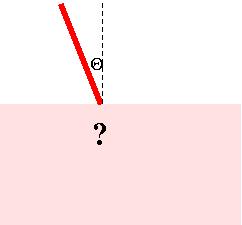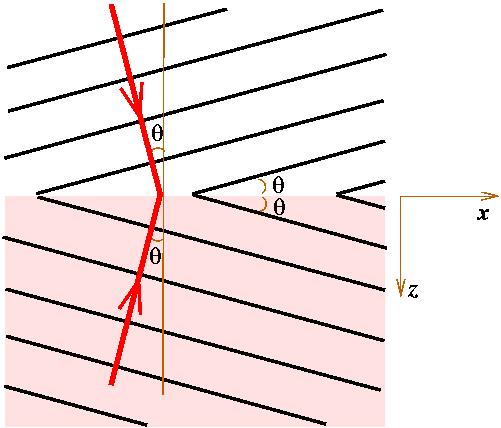
Answer to the Question 02/05
NEGATIVE INDEX
The question was:

A ray of light is incident on a boundary between vacuum and
material that (at that particular frequency) has dielectric
constant ε=-1 and magnetic permeability μ=-1. (Strictly speaking,
these quantities must also have imaginary parts. We will assume
that they are very small.) The incidence angle is θ. What can you say about
the direction of the reflected and the transmitted rays.
(4/06) We received several solutions of varying in degree of detail,
accuracy and completeness.
Ioannis Florakis from the University
of Athens, Greece
(e-mail iflorakis@yahoo.gr)
provided us (on 25/1/06) with the most complete solution.
The answer:
The angle of refraction is equal to the angle of incidence; however, the
refracted ray is on the same side of the normal as the incident ray - see
the figure below. The reflection angle would be equal to angle of incidence
(in the "normal" direction) if the material properties would be slightly
different; however, for the given values of ε and μ we have
a perfect transmission, i.e. there is no reflected wave.
The solution:
Consider an incoming ray at angle θ approaching a horizontal interface
from above. We denote coordinate perpendicular to the interface z,
and the coordinate along the interface (in the incidence plane) x,
as can be seen in the picture below. (Positive z axis is directed
downwards). First of all we note that the index of refraction n, which is
a square root of the product ε*μ=(-1)*(-1)=+1, must be either
+1 or -1. In order, to understand which sign of the square root should be
chosen, consider, both ε and μ as complex numbers of, say,
absolute value (module) 1, and the argument (angle with real axis) changing
from 0 to π. The angle must be positive, since the imaginary parts of
both constants are positive due to energy conservation. Thus the argument
of the product will increase between 0 and 2π while the argument of
the square root will increase till π, indicating that the proper result
of the square root is -1. If we apply, n=-1 to Snell's law, we will get
a negative angle of refraction, indicating that the direction of the
refracted ray is on the same side of the normal to the surface as the
incoming ray.
However, in this case, it is very instructive to make more detailed
analysis, in order to understand the true reason of such "reversal"
of the angle. Snell's law is a consequence of continuity conditions
of the fields at the interface. Consider an incident monochromatic
plane wave moving in direction described by a wave-vector k
towards the interface. Black lines
in the picture below depict consecutive maxima ("crests") of the wave,
and the red arrow depicts the direction of k. Let the refracted wave
be described by k'. Since the continuity conditions must be
satisfied at any moment, the frequencies of incident and refracted
waves must coincide. Since the squared ratio between |k| and
frequency is proportional to ε*μ, we find that
|k|=|k'|. Since, the continuity conditions must be
satisfied at all points along the interface, the dependence of
both waves on coordinate x must be identical, and consequently
the x-components of the wave-vectors coincide:
kx=k'x. This is indicated by the
"crests" of the waves coinciding along the interface. Since
k2=k'2, it follows that
|kz|=|k'z|. However, in Maxwell's
equations the wave-vector, the electric and magnetic field vectors
are related. Using these relations, as well as continuity of, say,
component of the electric field parallel to the interface, and
component of the magnetic field (induction) perpendicular to the
interface one can verify, that kz=-k'z,
as shown in the picture. (One should also use other components suitably
multiplied by material properties.)

Everything that was described above can be found in standard texts
of electrodynamics, see e.g. the textbook of J.D.Jackson, Classical
Electrodynamics (Wiley, NY). Although, the standard texts do not
consider such extreme values of the properties of materials, you can
obtain the above results by substituting the values of ε
and μ into the formulas of Jackson in the chapter on "Plane waves".
The analysis of reflection coefficient is even more complicated, and
is usually performed by separately considering the case of a wave polarized
in - and perpendicular to - the incidence plane. Substitution
of the material values into the such formulas, will show, that although
the reflected wave was supposed to have the "usual" angle of reflection,
the reflection coefficient vanishes and there is no reflected wave.
Comment: This problem was first considered by V.G. Veselago
(Soviet Physics Uspekhi 10, 509 (1968)),
and was almost forgotten. Recently the interest has been revived due
to possible applications to "perfect lenses" as well as due to the technical
abilities to produce materials with very exotic dielectric and magnetic
properties (see J.B. Pendry, Phys. Rev. Letters 85, 3966 (2000);
here is a copy of the article in PDF format).
 Back to "front page"
Back to "front page"



 Back to "front page"
Back to "front page"